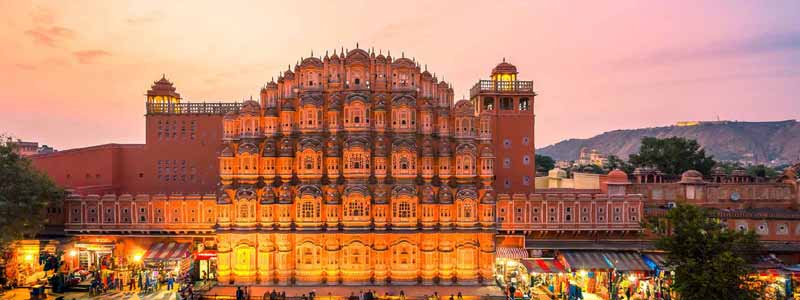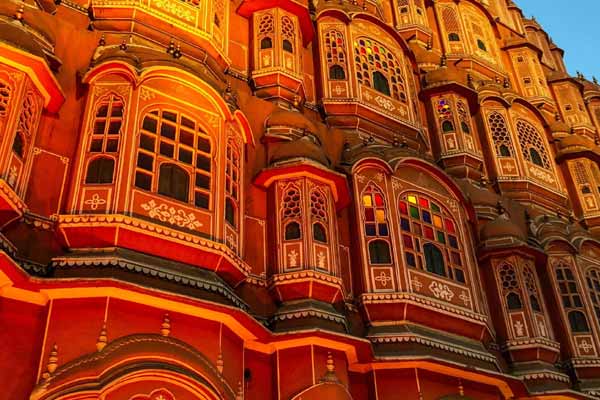Top 6 Places to Visit in Jaipur or the Pink City is the hub of exotic destinations. From the marvelous palaces depicting the royal history of Rajasthan, the pink city is abundant with places to visit in jaipur. With its glorious past, there are plenty of things to see in jaipur. Feels like a journey through time, the visit to Jaipur fills your eyes with the city’s rich traditional and cultural history, Jaipur is a princely wonderland of culture and heritage, brimming with architectural gems. It’s also a preeminent stop in India’s famous Golden Triangle, a popular tourist circuit.
Prepare to be captivated by the grandeur of Jaipur, the capital of Rajasthan. City Palace gives you a taste of the lavish lifestyle afforded to the royal family of Jaipur. Just next door, the astronomical instruments at the Jantar Mantar observatory bring the mysteries of space down to Earth. And depending on the time of your visit, you may be able to experience one of the many festivals that fill Jaipur’s annual calendar, like the International Kite Festival in January or Elephant Festival in early spring.
Ready to make your trip to “The Paris of India” a memorable experience? Map out your itinerary with our guide to the top attractions and Top 6 Places to Visit in Jaipur.

Hawa Mahal
Known as the ‘Palace of winds”, this five-story building was built in 1799 by Maharaja Sawai Pratap Singh. This palace is decorated with 953 windows or ‘Jharokhas’ which are adorned with intricate designs. It is the popular place to visit in two days for a family trip.
There’s a small museum within the complex of Hawa Mahal, which houses famous items like miniature paintings and ceremonial armor Jaipur Tour Packages.
The main reason behind the making of Hawa Mahal was to felicitate Rajput women who were not allowed to appear in public places. Through this fort, all the women used to catch the glimpses of royal processions, hustles, and bustles of the city.
Entry Fee: INR 200 for Foreign Tourists and INR 50 for Indians
Visiting Hour: 9:00 AM – 4:30 PM
Amber Fort
Also referred to as the Amber Palace, the fort is located on a hill in Amer, Rajasthan. Built by Raja Man Singh, the fort, which is also spelled as Amer fort, is a scenic marvel. It stands on top of an easily scalable mountain, which is situated right next to the beautiful Maota Lake.
The fort presents a fascinating blend of Hindu and Muslim architecture. It is built using red sandstone and white marble. The palace complex of the Amber Fort has very attractive apartments. It is the most nearest place in jaipur with 50kms.
This complex was built by Raja Man Singh, Mirza Raja Jai Singh, and Sawai Jai Singh over a period of about two centuries. This palace complex was used as the main residence of the Rajput Maharajas for a long period of time Top 6 Places to Visit in Jaipur.
Visiting Hour: Rs.100
Visiting Time: 10 AM – 5 PM (Daily)
Jantar Mantar
The Jantar Mantar in Jaipur is the largest and one of the best preserved of five observatories constructed by Maharaja Sawai Jai Singh all over northern India. It is marked as a World UNESCO Heritage Site.
He took nearly seven years to finish the Jantar Mantar. It was restored in 1901 and in 1948 the famous observatory was declared a national monument.
The Jantar Mantar in the Pink City consists of multiple structures of stone masonry built in varied and large geometric forms that have caught the attention of artists, architects and art historiographers throughout the world and Top 6 Places to Visit in Jaipur near railway station.
He also constructed five different observatories in North India including Jaipur, New Delhi, Ujjan, Varanasi and Mathura.
Visiting Hour: 9:00 Am to 4:30 pm, on all seven days of the week
Albert Hall Museum
Housing the ultimate charms of Royal Rajasthan, the Albert Hall Museum is considered as the finest gallery in Jaipur. This veritable museum was designed by Colonel Sir Swinton Jacob on February 21, 1887, to impress King Edward VI and currently includes more than 24,930 exhibits.
The museum complex is a proud example of Indo-Saracenic architecture which features beautiful pillars, arches, and vast courtyards. Exhibits include an eternal collection of paintings, arms, weapons, sculptures, tribal art, textiles, jewelry, musical instruments, clocks, and hundreds of other such spectacular items that can keep a visitor enthralled for hours Top 6 Places to Visit in Jaipur.
Fee: 150 Per Person for Foreign Tourists and Rs. 20 for Indian Tourists
Visiting Time: All days of the week 9:00 AM – 5:00 PM
City palace
The palace was constructed by Maharaja Sawai Jai Singh II. Like most structures in Jaipur, this palace also reflects the fusion of Mughal and Rajput architecture. The City Palace complex is spread over a large area occupying one-seventh of the old city of Jaipur.
It has a sequence of gardens, buildings, and courtyards, temple, and museum to give it a grand view that reflects its historical importance and magnificent royal grace Top 6 Places to Visit in Jaipur.
One of the famous items in the City Palace is two silver jars that have found a place in the Guinness Book of World Records as the largest silver vessels in the world.
Apart from Mubarak Mahal and the Chandra Mahal, there are Pritam Niwas Chowk, Diwan-i-Aam, Diwan-i-Khas, Bhaggi Khana, Maharani Palace and the Govind Dev Ji Temple, an 18th-century structure.
Entry Fees: Rs. 100 to view the exterior spaces and for the museum, Rs. 130. For foreigners, it is 500 and Rs. 900. You may also buy a composite ticket.
Camera Charges are Rs. 50 and Videography charges are Rs. 150
Visiting hour: 9.30 to 5.00
Galtaji temple
Located on the outskirts of the regal city of Jaipur, Galtaji Temple is a prehistoric Hindu pilgrimage site. Outlined by the striking Aravalli hills, it consists of several shrines, holy kunds, pavilions, and natural springs.
This majestic temple is situated in the heart of a hilly terrain that is bounded by a beautiful gorge that attracts tourists here every year. Galtaji Temple was built using pink color sandstone and is a vast temple complex housing varied shrines.
Located inside the City Palace, the walls of this temple are beautifully adorned with carvings and paintings that make this place worth visiting.
The Galtaji Temple is situated in the Aravalli hills and is bounded by thick plush trees and bushes. This remarkable building is decorated with painted walls, round roofs, and pillars.
Apart from the kunds, this pre-historic Hindu pilgrimage place also has temples of Lord Ram, Lord Krishna, and Lord Hanuman within the temple. One of the main tourist destinations of Jaipur, the temple complex boasts of natural freshwater springs and seven holy ‘kunds’ or water tanks.
Among these kunds, the ‘Galta Kund’, is the holiest one and is believed never to get dry. Pure and clear water flows from the ‘Gaumukh’, a rock shaped like a cow’s head, into the tanks.
